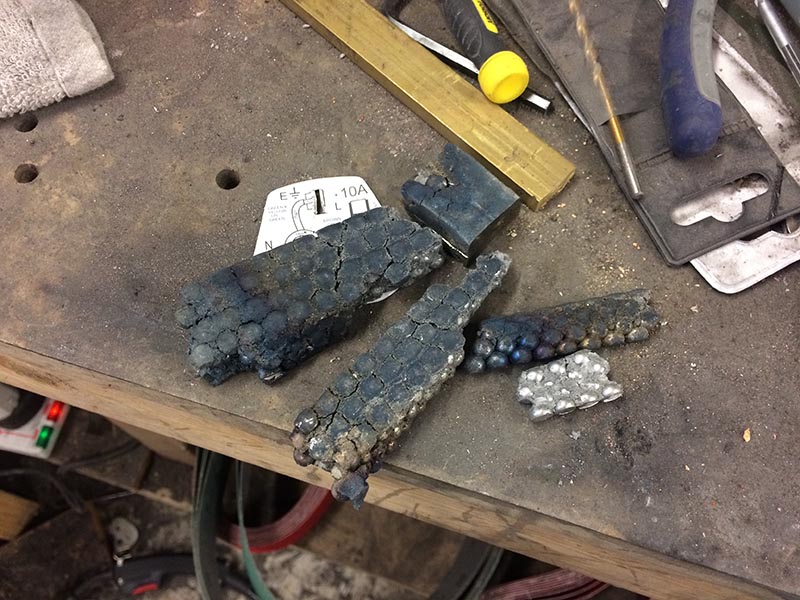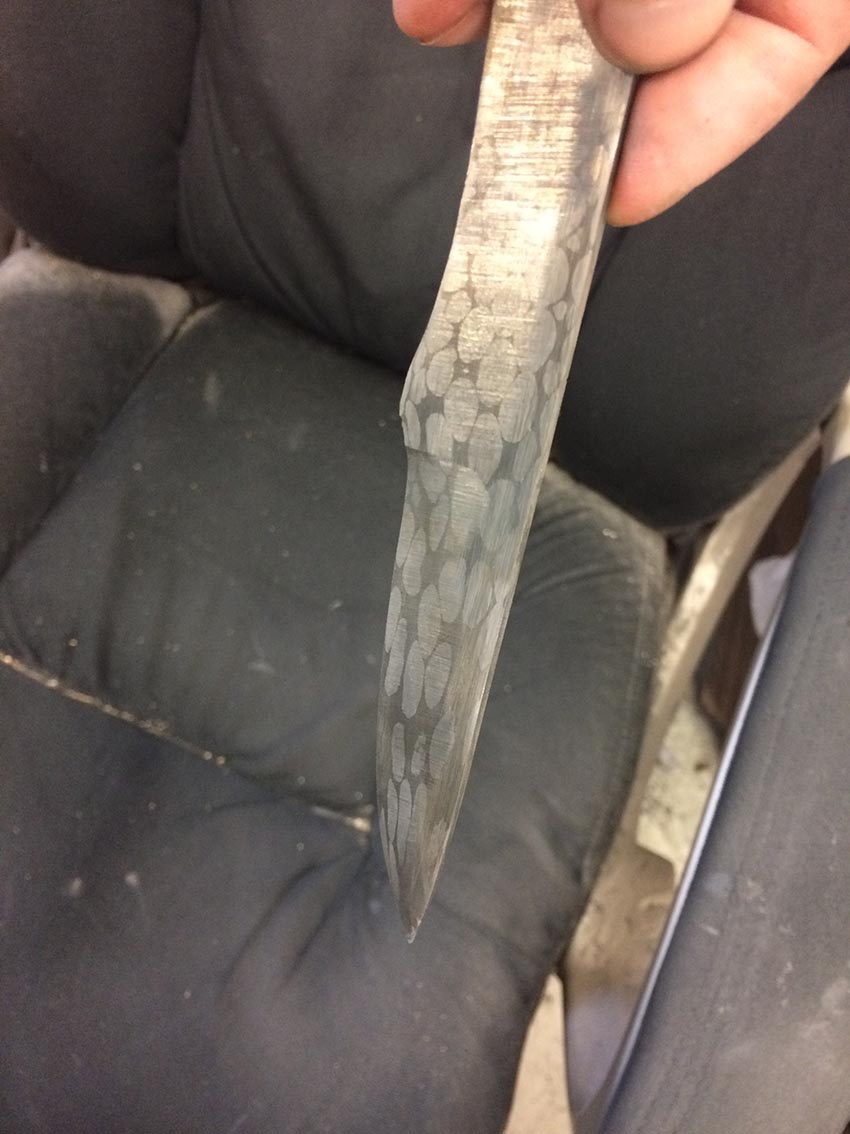Hi everyone, after successfully forge welding some san mai last week I got a little adventurous and had a go and some ball bearing canister damascus today. This was quite a bit less successful. Here's what came out of the canister:
What did I do wrong here? Was it simply not hot enough? I had it yellow hot and it moved very easily under the hammer, but I may have just underestimated how hot I needed it. Any input is appreciated!
Paul I use standard welding heat, but with canister you have to let it soak so that welding heat goes all the way into the middle. It did not get hot enough inside is what it looks like.
Brion
Brion Tomberlin
Anvil Top Custom Knives
ABS Mastersmith
Thanks Brion. Do you have any suggested soak times? I was using a 1" square canister.
Hello Paul
I would suggest you bring it up to a welding heat and soak for 10 - 15 min. Make notes on what you do. Record your soak time, and the canister size.
This helps you to figure out what didn't work, and you have notes for the next one.
Are you using a gas or coal forge? You could over heat it in a coal forge. Soak time is very important on a canister.
There are a lot of small voids, depending on how much powder steel you have in the can, it compresses a lot.
Good Luck on the next one!
Russell
I know of a few M.S. (Nielson and Caffrey) that have inexpensive videos out there specific to canister Damascus that you might consider viewing (there may be more that I'm unaware of).
In Ed Caffrey's video he talked about the time and temperature involved to be successful with the huge canister he was working with. I'm on the road right now so I don't have the info at my fingertips but I do remember that canister being in the forge for quite some time.
Thanks Matt. Now that you mention it I remember seeing some of Neilson's vids on his website. I'll take another look, I'm sure he has something useful given it's kind of a speciality of his.
Russell, I'm working with a gas forge so consistent temps shouldn't be a problem. I filled the can as much as I could with powder and tapped it down until there was no more movement.
Not enough heat, nor enough duration at heat. When your "can" looks like it's ready to weld....leave it there for 30-45 MINUTES. In my shop if any type of powder is involved in a billet, the soak time at welding heat is 30 mins minimum. It might sound excessive, but you have to consider that EVERY piece within the "can" must get to welding temp in order to work.
The other aspect is the amount of compression/reduction. In general, it requires approx. a 50% reduction in size to get everything welded/all the seams sealed. That's not just from one side... all the way around. What that means is that if you start out with a 1" square "can".... you're going to want to get it to a 1/2" square to ensure everything is solid.
I rarely start with anything less than a 3"x3" can X whatever length your press dies might be....the reason is that IMO, it has to get to as least 1 1/2" to ensure everything is welded/solid. While "can" can be done with a power hammer with FLAT dies, it's a bit tricky to get it welded. A press makes it far easier.
In the case of what you attempted (round bearings), unless you add a bit more powder, it will take more reduction to weld, because of the rounded surfaces of the bearings.
It'll come..just keep at it. I find that any time I build a "can", depending on the what components I use, I have to deal with different variables.
Ed Caffrey, ABS MS
"The Montana Bladesmith"
www.CaffreyKnives.net
Thanks Ed. I'm working without power tools like a press or power hammer, so I thought more than 1" would be potentially more than I could chew. I will give it another go at this size just to see if I can do it with hand hammering, before I go chasing something bigger!
I was wondering if you were doing it by hand. That's a tough one.....LOTS of hard work. The toughest part by hand is achieving the reduction/level of compression necessary to seal/avoid voids. Not that it's can't be done, it's just gona take work and perseverance. <img src=' http://www.americanbladesmith.com/ipboard/public/style_emoticons//wink.gi f' class='bbc_emoticon' alt=';)' />
Ed Caffrey, ABS MS
"The Montana Bladesmith"
www.CaffreyKnives.net
I thought i would chime in as i have been experimenting with making canister ingots myself over the last 2 months, and feel i should show proof so here are two pictures all are made using 2 inch tubes. the first picture shows my failures and first viable ingot.
I have also been doing it by hand and feel i can shed a bit of light on how to do it by hand. I don't really have a good sense of time, however luckily I was listening to music when i made The glowing ingot. It took me about two hours to set, i gave it around a 3-4 song/10 minute soak, then flipped it for around and let it soak for another 2 songs. then i pulled it out and started setting the ingot vertically and hammered it with a 2000 Gram hammer (4.4092 pound) hammer a few times then i hammered on it horizontally. once it goes to orange i threw it back into the fire for another 6-10 minutes with a single turn and another soak, repeat the hammering. i think i did this 6-8 times however i did lose count. well i am kinda rambling here the important thing i am trying to say is you need to hit it both vertically and horizontally several times.
Tip: Any white paint that uses Titanium for its pigment will prevent the can from sticking. titanium white pigment is extremely common and its used in most white paint. I use this stuff https://smile.amazon...f=ast_p_ep&th=1 and take the time to thin it out using water. As long as I do not spill the paint, i would say it should last me at least 50 canisters. i do at least 2 coats of it per can and speed dry it using a heat gun. I would give the formula on how much i thin it out but i did it visually so i honestly cant. I hope this helps, keep up the good work.
PS: if you used say 1084 or 1095 as your powder you could brake your first try in to bits and order some of this https://usaknifemaker.com/4600kc-powdered-metal-fine-mesh-5lbs.html to give it a more unique and interesting contrast. Im doing this with my own failures the 3 cans of this stuff i ordered gets here. =)
Thanks everyone for the input. I had another try with the 1" tube. I used 1084 powdered steel and 52100 4mm ball bearings. Soaked it for 15 minutes and started hitting it. I wasn't really timing things, but I think it took about an hour to get it to the point where it had compressed a decent amount and was a solid piece inside the tube. When I cut the tube off (liquid paper mostly did a pretty good job of stopping it from welding together) I had a relatively solid piece that was about 0.6" square and maybe 6" long. I was able to work on it again today and drew it out into a billet before forging it into a knife shape.
Still some way to go before I can call it a knife, but I feel pretty confident I can say that I have now made some canister damascus!
nice work Paul . yesterday my friend Dan and I did cannister Damascus with 1084 and 1/4" bearing third try was the charm as we got a reasonable piece. the first two taught us to soak it longer also . it ended up 35mins then hand set all four sides reheat and repeat three times then used his power hammer the . same way. we ended up on the third piece with edge fractures after drawing it out. not sure why. time to review and study. the nielson DVD is very helpful your post has been helpful also to bad I didn't see this before



